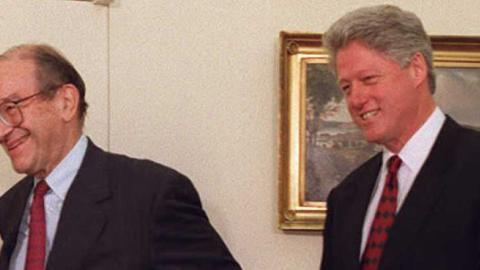In a highly provoking opinion-piece, (Alan Greenspan’s “Irrational Exuberance”: Then and Now, Realclearmarkets, August 16) Alex J. Pollock (R Institute) looks back at Alan Greenspan’s notorious call In December 1996 that the US stock market was suffering from irrational exuberance:
When Greenspan gave the speech at AEI, the inflation-adjusted NASDAQ stock index was 1392 – three times as high as at end 1987. After the speech the market continued its rapid ascent for three more years. By end-1999, the inflation adjusted Nasdaq index was 4106, three times higher than when Greenspan had issued his warning. Then came the market collapse and by September 2001, five years after the speech, real prices were back to where they had been in December 1996.
All very humbling for Mr. Greenspan, for whom “the concept of irrational exuberance came in the bathtub one morning”. To be precise, Greenspan had put his remarks in the form of a reasonable question: “How do we know when irrational exuberance has unduly escalated asset values, which then become subject to unexpected and prolonged contractions”. But the audience and the press got the message that he was worried that stock prices were too high.
Alex Pollock comments that now the real Nasdaq index has increased by a multiple of about four times since its low point of February 2009. On July 31, 2017, Greenspan issued a new bubble warning (though focused on the bond market) (“Long term interest rates will rise and that is not good for asset prices”).
Mr. Pollock concludes “It seems to me that this (warning) is directionally correct. Will Greenspan’s timing prove to be better this time than last?” No answer as yet!
In today’s note the bold (or foolhardy) purpose is to explore an answer!
Why first of all was Mr. Greenspan’s diagnosis so spectacularly wrong?
There are two obvious big faults to consider.
First, the then Fed Chief showed no foresight then that the US and global economy had entered a rare but not unparalleled era of rapid globalization and technological change. The internet, the collapse of the Berlin Wall, and the integration of China into the global economy were developments with their closes parallel in the economic miracle years (for the US in particular) of the mid-1870s to the late 1880s.
Second, as Mr. Greenspan (in step with, not in advance of the market) came to suspect subsequently that abnormally good times were at hand he responded by creating vast monetary distortions which fueled irrational forces in asset markets to a degree unparalleled in economic history (with the possible exception of 1924-29).
How did he and his fellow Fed members create such distortion?
They saw the subdued level of inflation as grounds for resisting the sharp upward path in rates which would have accompanied such economic miracle under a sound money regime. The natural rhythm of prices was then downwards (reflecting rapid productivity gains and globalization); Mr. Greenspan sought to resist that natural rhythm – and indeed all but concurred with a position paper by Dr. Yellen (then a Fed board member) in July 1996 that the Fed should take a break in tightening monetary conditions now that inflation had fallen to 2% p.a..
With rates artificially held down the scope for positive feedback loops between capital gains in the equity market and a reinforcement of speculative hypothesis-building was great. And Mr. Greenspan and his Fed colleagues did a good job of mixing in a powerful monetary narrative to feed the irrational exuberance. According to this narrative, the Fed could always act to limit stock market falls (as it did swiftly in the midst of the Asian debt crisis which erupted in summer 1997 or the Russian debt crisis a year later); more broadly, the Fed had found the mix of policies which would guarantee a nonending “Great Moderation” (no serious recessions or crises in the future).
Fast forward to the present! Can we find fault with the widely broadcast skepticism of many market pundits regarding today’s US stock market valuations?
Yes, a restoration of economic miracle is conceptually possible. The miracle was aborted by the great monetary blunders which culminated in the giant bubbles and bursts of 1999-2003 and 2007-2011. Maybe there is still considerable catch-up in prosperity to reflect accumulated technological change and globalization.
This is nowhere near a mainstream scenario or likely scenario given the deterioration in wider economic, social, political and geo-political climate which has occurred, some traceable to the monetary disorder itself; and the latter has created so much pent-up financial stress and monetary uncertainty. But never say no to economic miracle (even in the form of a re-birth of one aborted earlier). Just one word of caution even here: the miracle most likely would go along with much higher interest rates and a bounce in real wages and in the total amount of capital investment – and so earnings per share (adjusted for retained profits) might not reflect the resumption of fast growth; indeed fast growth might come in a form which reduces many present high monopoly rents.
Could the monetary magicians produce yet another explosive growth in equity values, such as Mr. Greenspan achieved through 1997-9? The answer here is “HIGHLY DUBIOUS”. What do we not now know about the power of the Fed to create asset price inflation? Everyone and their dog realize exactly what the Fed is up to – the only issue which separates them (in their opinion of ideal strategy) is how long the music will continue and up until what time they can safely get out.




















